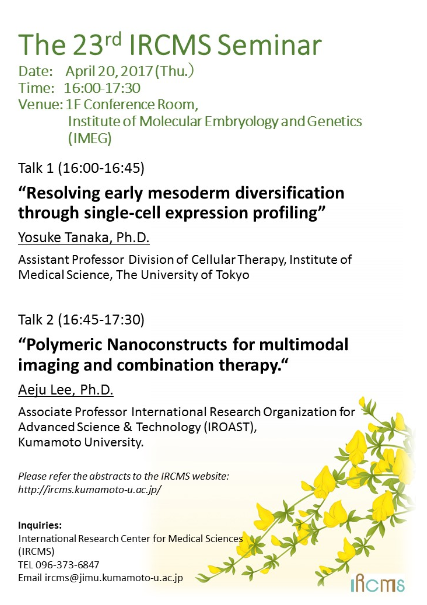- HOME
- IRCMS Seminars
- 23rd IRCMS Seminar
IRCMS Seminars
23rd IRCMS Seminar
April 20 2017
We had a large number of participants come to the 23rd IRCMS Seminar held on April 20, for which we would like to express our gratitude.
Date: April 20, 2017 (Thu) Time: 16:00 - 17:30
Venue: 1F Conference Room, Institute of Molecular Embryology and Genetics (IMEG)
Talk 1 Yosuke Tanaka, Ph.D
Assistant Professor, Division of Cellular Therapy, Institute of Medical Science,The University of Tokyo,
"Resolving early mesoderm diversification through single-cell expression profiling"
In mammals, specification of the three major germ layers occurs during gastrulation, when cells ingressing through the primitive streak differentiate into the precursor cells of major organ systems. However, the molecular mechanisms underlying this process remain unclear, as numbers of gastrulating cells are very limited. In the E6.5 mouse embryo, cells located at the junction between the extra-embryonic region and the epiblast on the posterior side of the embryo undergo an epithelial-to-mesenchymal transition (EMT) and ingress through the primitive streak (PS). Subsequently, cells migrate, either surrounding the prospective ectoderm contributing to the embryo proper, or into the extra-embryonic region to form the yolk sac (YS), umbilical cord and placenta. Fate mapping has shown that mature tissues such as blood and heart originate from specific regions of the pre-gastrula epiblast but the plasticity of cells within the embryo and the function of key cell type-specific transcription factors remain unclear. Here we analyse 1,205 cells from the epiblast and nascent Flk1+ mesoderm of gastrulating mouse embryos using single cell RNA-sequencing, representing the first transcriptome-wide in vivo view of early mesoderm formation during mammalian gastrulation. Additionally, using knock-out mice, we study the function of Tal1, a key hematopoietic transcription factor (TF), and demonstrate, contrary to previous studies performed using retrospective assays, that Tal1 knock out does not immediately bias precursor cells towards a cardiac fate.
Talk 2 Aeju Lee, Ph.D
Associate Professor, International Research Organization for Advanced Science & Technology (IROAST) Kumamoto University
"Polymeric Nanoconstructs for multimodal imaging and combination therapy"
Development of highly sensitive and specific nanoconstructs is one of the most important part in Theragnosis (Therapy &Diagnosis). Nanoconstructs has multi-functional potential for diagnosis of disease and monitoring drug delivery as well as response to therapy. I report protease activatable strategy based on a polymeric nanosensor. Proteases are the most important and extensively studied enzymes owing to their various regulatory roles in biological processes. These methods mostly rely on a peptide substrate that becomes fluorescent in vivo. The design platform of the nanosensor is flexible and fine-tunable for a wide array of applications such as detection of biomolecules, early diagnosis of disease, and monitoring therapeutic efficacy in vivo. In addition, activatable fluorogenic peptide can be replaced in therapeutic drugs (i.e., chemotherapeutic agents) to allow both imaging and therapy.
Also, nanoconstructs can simultaneously deliver multiple agents to disease lesions enabling de facto combination therapies. Perhaps, even more interesting is the fact that nanoconstruct can be engineered to deliver different therapeutic agents to a disease site simultaneously impacting multiple subcellular targets. In this respect, growing evidence suggests that combinatorial therapies, where conventional antitumor drugs are administered together with molecularly targeted agents, are more promising than traditional "one-size-fits-all" therapeutic approaches. By simultaneously loading and delivering different molecules into nanoparticles, the benefits of combinatorial therapies could be enhanced even more.

